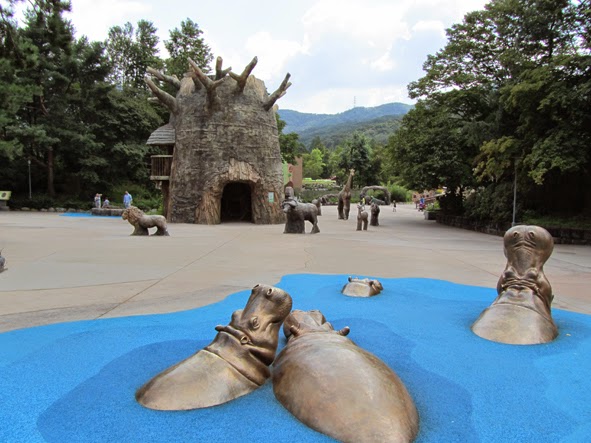In
September 2012, I had the opportunity to visit Seoul Zoo which is located at the
border of the Seoul and Gwacheon Districts in
the Republic of Korea
A Really “Grand” Park
Seoul Zoo is located within
the
If
I recall correctly, the ticket for the tram was 800 Korean won. Admission to the zoo itself was 3000 won.
There
was a large tiger statue near the zoo entrance.
The
zoo grounds are so wide-spread that they have shuttle trams on routes circling
the inside of the property.
There
is also a chairlift that travels the full length of the zoo, exits the zoo, and
returns back to the area where you first boarded the trams. Riding this lift will add a little thrill to
your visit as there are a few worrisome stretches where it takes you over heavy
vegetation in the zoo and over a lake in the park. If you drop your cellular phone or any other
possession, you will have to consider it lost for good.
Gardens of Art
The grounds feature many carefully
maintained plants and shrubbery and a number of animal-related artworks.
There
is even a plaza where metal hippos appear to be sticking their heads out of a
blue gravel pond.
The Tigers
Since
the amount of time allotted to explore this zoo was short, I decided to concentrate
on at least getting some decent photographs and video of the Amur tiger (Panthera
tigris altaica) enclosures. At the “Beast
Pavilion”, there were two open-air enclosures housing two tigers each. These enclosures were separated from visitors
by a deep concrete dry moat.
At
2:30pm., the tigers were fed some chicken.
Explanation
sign for tiger enclosure: other than the name of the animal, everything was
written in Korean.
One
of the open-air enclosures with dry moat.
Below
is a video of this exhibit.
There
were also two large cage-type enclosures.
One housed Amur tigers, one housed white tigers. (Because of the negative aspects and health
risks associated with intentionally inbreeding animals to achieve rare
color-morphs like white tigers, many zoos do not keep white tigers.)
There
was even a food stand decorated in a tiger motif.
Other Exhibits
Entrance to “Ape Pavilion”.
This
exhibit utilized electrified wires and a deep dry moat to keep the animals from
escaping.
The “Oriental
Pavilion” housed snakes, crocodiles, and monkeys.
“Bear
Pavilion”
Dolphin
show at “Marine Pavilion”.
The
physical size of this zoo was really impressive. Looking at the map I brought home, I realized
that I only managed to walk through about one-third of the property. Without question, this is one zoo that I
would like to someday revisit.
(Note:
All photos taken in this post were taken during a visit on September 10, 2012. The comments in this post are based on
observations made on that day.
Conditions may have since changed.
Please check it out for yourself!)



























